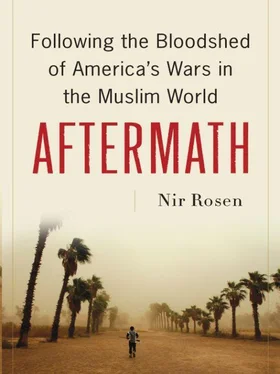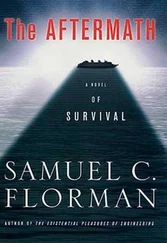The sermon that followed the prayers elaborated the nationalist sentiments on the banners. Baghdad had been occupied by the Mongols, Kubeisi said, referring to the sacking of what was then the capital of the Muslim world in 1258. Now, new Mongols were occupying Baghdad; they were destroying its civilization and creating divisions between Sunnis and Shiites. The Shiites and Sunnis were one, however, and they should remain united and reject foreign control, he said. They had all suffered together as one people under Saddam’s rule. Saddam had oppressed all Iraqis and then abandoned them to suffer. There were no Sunnis or Shiites, Kubeisi said. All Iraqis were Muslims, and they had defended their country from the Americans and British as a united people. Kubeisi also thanked the Shiites of Basra for “defending their country against the foreign invaders.” He demanded an administration governed only by Iraqis and a council of Shiite and Sunni scholars to oppose any government the Americans tried to establish. “We fear that sectarianism will be exploited by our enemies,” he said, referring to the Americans, and urged unity between Sunnis and Shiites. “We will reconstruct our country,” he said, rejecting American interference and “a government that will oppress us,” calling instead for elections. He mocked the “continuous lies” that the Americans had come to get rid of Saddam’s weapons of mass destruction. “Where are these weapons?” he demanded. The Americans were the enemies of mankind, and had come for Iraq’s oil, he said. The American occupiers were the masters today, but they should not consider staying in Iraq. “Get out before we expel you,” he said, warning of the humiliation they would suffer. The sermon ended with shouts of “God is great!”
The parallel with the fall of Baghdad to the Mongols in 1258 was ominous. It had shocked Muslims in the thirteenth century. Theologians like Taqi al-Din ibn Taimiya (1263-1328) from Aleppo in modern-day Syria blamed Muslims for failing to be sufficiently devout. A wave of conservatism spread throughout the Muslim world, trying to return Islam to its original purity. Often quoted by Osama bin Laden, Ibn Taimiya is the spiritual father of radical Sunnism, in particular the Wahhabi form of Islam dominant in Saudi Arabia and the general Salafi trend dominant in international terror movements like Al Qaeda. Taimiya viewed offensive jihad as a duty of every Muslim and expressed extreme hatred for Shiites, who were treated as apostates. He even blamed Shiites for the Mongol sacking of Baghdad. Ayman al-Zawahiri, the Egyptian fundamentalist who acts as Al Qaeda’s ideologue, has also relied on Taimiya’s fatwas, written as the Mongols devastated Baghdad. The Saudi government has been distributing the works of Taimiya throughout the world since the 1950s.
Across from the Abu Hanifa Mosque I found a shop selling magazines that promoted Taimiya’s thoughts. Perhaps more ominous, many Sunnis blamed Shiites for the betrayal that led to the fall of Baghdad. In the thirteenth century the sultan had a Shiite adviser called Ibn al-Alqami, who was said to have sold out his people and helped the Mongols. Abu Musab al-Zarqawi and other Salafi jihadists would later curse Shiites as the “grandsons of Ibn al-Alqami” for their collaboration with the Americans, the new Mongols.
Also in attendance at prayers that day was Sheikh Muayad al-Adhami, whom Kubeisi appointed as the new leader of the mosque. Adhami was angered by the entry of American marines into his mosque the previous week. The marines, who had not removed their shoes and had carried weapons, had violated Iraqi dignity, he said. Kubeisi’s close ties with the previous regime in Iraq would allow him to galvanize the Sunni elite and lead the community that had become disenfranchised with the end of the regime. There were few other Sunni personalities as well-known. His previous five years in exile created the false impression that he too had been opposed to Saddam, and he would attempt to use this to forge ties with former opposition figures who had returned. In the early months of the occupation, Kubeisi’s followers held joint demonstrations and prayers with anti-occupation Shiites such as the Sadrists. Their constant message was “ maku farq, ” meaning “there is no difference” between Sunnis and Shiites: “We are all Muslims.” But in retrospect they were protesting too much; behind the stentorian insistence that they were all united was the fear that they were not and the knowledge of what would happen should this secret become known.
When Supreme Council leader Abdul Aziz al-Hakim became head of the Iraqi Governing Council in late 2003, he began distributing land in Adhamiya to Shiites in order to increase its Shiite population, and he supported the construction of Shiite mosques there. But these mosques were often attacked, and some were blown up while still being constructed. Tensions continued to escalate. After Saddam’s capture in December 2003, rumors spread in Adhamiya that it was not their beloved leader after all. Residents emerged to celebrate, carrying pictures of Saddam and wielding Kalashnikovs and even RPGs. They clashed with U.S. troops, and locals maintained that U.S. forces were accompanied by the Supreme Council’s Badr Brigade. Others claimed that Iraqi police from Sadr City attacked the Sunni revelers. Residents of Adhamiya accused these forces of raiding the hospital to arrest those they had wounded. It was the first time Sunnis accused Shiite militias or security forces of attacking them.
Adhamiya remained a bastion of support for the resistance. Although most of the resistance in that area was not Salafist, following the destruction of Falluja by the Americans in late 2004, a large number of Zarqawi’s Tawhid and Jihad fighters moved into a building called Ras al-Hawash, which was close to the Abu Hanifa Mosque. There were foreign fighters among them, and they enjoyed the hospitality of the neighborhood’s families and employed local youths to collect information on their behalf. One test of bravery they gave local youths seeking entry into their group was to challenge them to place the flag of Tawhid and Jihad on the walls of the Abu Hanifa Mosque.
At the same time as I was tracking the fate of the Abu Hanifa Mosque and the neighborhood around it, I was also curious about the neighborhood of Ghazaliya and would visit it often. Built in the 1980s for Baath Party members and Iraqi army officers, it had twelve Sunni mosques but none for Shiites, even though the area was mixed—Saddam had refused to allow Shiite mosques to be built there. Sunni mosques in Iraq rarely attracted the same large crowds as their Shiite counterparts. Sunnis merely went to the closest mosque in their neighborhood, which in this case was the Um Al Qura Mosque. Built by Saddam at the cost of $7.5 million, the mosque was originally named Um al Maarik (Mother of all Battles) but later changed to Um Al Qura (Mother of Villages), a reference to Mecca. The mosque served as a symbol of Saddam’s turn to Sunni Islam to legitimize his rule, and commemorated his glorious (albeit failed) battle against the United States and its allies in the Gulf War. A plaque by its door said it was “built by the order of President Saddam Hussein, may God keep him.” Its minarets are visible from a great distance, four of which are shaped like Kalashnikovs and four like Scud missiles, and its dome is taller than most in Iraq. The bright white marble mosque is surrounded by a moat shaped like the map of the Arab nations, and has a huge parking lot that has not been full since the heady days of the spring of 2004. Inside it feels more like a Gothic cathedral than any other mosque I have been to. It is silent, with natural light coming in from up high. It is more vertical in its orientation than most, which have a tendency to feel horizontal. Its walls are cream-colored with green and gold decorations. The imam’s voice echoes like a Gregorian chant.
Читать дальше











